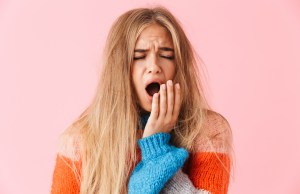Depression is one of the most well-known and studied mental health conditions. It’s characterized by feelings of sadness or emptiness, low energy, lack of concentration, and sleep and appetite changes, among a myriad of other symptoms, with episodes recurring over months or years. The different forms of depression are complex mental health conditions, all classified under the term depressive disorders.
Without proper depression treatment, depression can be a destructive barrier to stable mental health—one that erodes the sufferer’s quality of life and emotional well-being. Though the effects of depression can feel overwhelming, mitigating symptoms and finding relief from depressive disorders is possible with professional help.

What Is Depression? What Are the Types of Depression?
Depression isn’t a single condition, but rather a collection of closely related depressive disorders. It’s estimated that at least 8% of Americans grapple with depression annually. Some of the most commonly recognized depressive disorders include:
- Major depressive disorder: This is what most people think of when they hear the word “depression.” Symptoms of major depressive disorder include a combination of low or depressed mood, loss of pleasure or interest, weight or appetite changes, sleep changes, low energy, fatigue, feeling fidgety or slowed, experiencing worthlessness or guilt, challenges with concentration or thought, and thoughts of death. Those struggling with major depressive symptoms are at high risk of developing chronic physical health conditions alongside what they’re already experiencing emotionally. Major depressive symptoms must be present for more than 2 weeks to be formally diagnosed by a provider.
- Psychotic depression: This disorder is a subtype of major depression, but with features of psychosis, including hearing or seeing things that other people do not, or experiencing delusions. Psychotic depression is perhaps the most serious of all depressive disorders because it can increase the risk of self-harm and worsened psychosis.
- Persistent depressive disorder (PDD): Persistent depressive disorder is a type of depressive state that persists for two years or more. This depressive disorder presents common depressive symptoms (low energy, poor mood, lack of motivation) and can vary in intensity, but it must be present for at least two years in order for a provider to make a professional diagnosis. Though individuals with PDD may know how to navigate their symptoms, professional help is still needed to treat PDD effectively.
- Seasonal affective disorder (SAD): SAD is a form of depression caused by seasonal shifts in daylight hours and temperature. Though SAD is a condition that more commonly develops in the winter, summertime SAD is also recognized. The diagnostic criteria for SAD are the same as major depression, but in addition, a client’s depressed mood and loss of interest must drastically decrease or dissipate with the arrival of a change in season, such as passing from winter to spring. An individual must have also experienced a seasonal depressive pattern for two years or more.
- Peripartum depression: Peripartum depression affects women during pregnancy and following childbirth. This is an umbrella term encompassing prenatal depression (during pregnancy) and postpartum depression (after birth).
Depression also has a chemical basis, meaning that some have a higher likelihood of developing depression symptoms. For others, being depressed may actually contribute to a deficiency in the chemical compounds that help regulate mood within the brain. The chemical nature of depressive disorders (as well as other mood disorders) means that depression treatment involves addressing not only the emotional impact but the physical effects, too.
Recognizing the Signs of Depression
Common signs of depression include:
- Persistent sadness: A continuous feeling of sadness, emptiness, or hopelessness.
- Loss of interest or pleasure: A marked disinterest in activities that were once enjoyed, including hobbies, social activities, or sex.
- Changes in appetite or weight: Significant weight loss or gain unrelated to dieting, or a noticeable change in appetite.
- Sleep disturbances: Insomnia, waking up early, or excessive sleeping.
- Fatigue or lack of energy: Feeling tired all the time, even after a full night’s sleep.
- Feelings of worthlessness or guilt: Excessive or inappropriate guilt, or feelings of worthlessness.
- Difficulty concentrating: Trouble focusing, making decisions, or remembering things.
- Physical symptoms: Unexplained aches and pains, headaches, or digestive problems that do not respond to treatment.
- Suicidal ideation: Frequent thoughts of death, suicidal ideation, or suicide attempts.
These symptoms can vary in intensity and may not all be present in every individual with depression. If you or someone you know is experiencing these signs, it is important to seek help from a healthcare professional as soon as possible. If you need immediate mental health assistance, the 988 Suicide and Crisis Lifeline, as well as other resources, are available for you, with trained and informed professionals ready to help you through what you’re experiencing.
Who Is Most at Risk for Developing Depression?
Those who are at most risk of developing depression include:
- People with a family history of mental health conditions, especially depressive disorders
- Individuals already suffering from another type of mood disorder
- People with a past history of trauma or abuse
- Those with chronic physical ailments such as COPD or diabetes
- People who have suffered a brain injury or have imbalances in their brain chemistry
- Those with low self-esteem or chronic anxiety
- People with a history of self-harm, especially teens
Additionally, individual factors or life circumstances or transitions may make someone more susceptible to developing depression. The most productive way for people to gauge their full risk of developing a depressive disorder is to talk with a mental health professional who can evaluate and diagnose them.
What Exactly Causes Depression?
Depression is a complex and multifaceted condition influenced by various biological, psychological, and environmental factors. Common causes of depression include:
- Genetic predisposition: Individuals with a family history of depression are more at risk of developing depression. Additionally, structural and functional abnormalities in certain brain regions, such as the prefrontal cortex and hippocampus, have been observed in those with depression, suggesting a neurological basis for the disorder.
- Traumatic life events: Experiences such as loss, abuse, or chronic stress can trigger or exacerbate depressive episodes.
- Ongoing life stressors: Consistent stressors like financial difficulties, relationship problems, or work-related stress can contribute to the development of depression.
- Social factors: Lack of social support, isolation, or strained interpersonal relationships can foster feelings of loneliness and despair, worsening depressive symptoms.
- Cultural and societal influences: Cultural factors like stigma surrounding mental health and limited access to mental healthcare services, in addition to socioeconomic determinants of health, can impact the prevalence and manifestation of depression within communities.
It’s important to recognize that depression is a highly individualized experience, and what causes or exacerbates it can vary widely from person to person. Because of this, depression treatment often involves a combination of medication, therapy, lifestyle changes, and social support.
What Happens to Most People With Depression? Do Most People Survive Depression?
Most people do survive depression, particularly with the right combination of treatment, support, and self-care. Depression affects millions of people worldwide, but it is also highly treatable.
Treatment options such as medication, psychotherapy, and lifestyle changes have been shown to be highly effective. Prognoses improve significantly when individuals seek help early and adhere to their treatment plans.
While depression is a chronic condition for some, many people experience substantial improvement in their symptoms and lead fulfilling lives. Resilience, coping strategies, help from a mental health professional, and continuous support systems further enhance the likelihood of overcoming depression.
Hello, we're here to help you
We provide award-winning mental health services nationwide, with flexible scheduling & insurance coverage. Start your journey this week.
What Are the 3 Levels of Depression?
The three levels of depression refer to the number of depressive symptoms an individual exhibits. The three levels of depression are typically classified as:
- Mild: The least intense depression symptoms that typically appear at the beginning stages of depression. They are mild in intensity, only having a slight impact on daily life, but can include a number of symptoms from irritability to low self-esteem. Mild symptoms may seem less concerning, but over time they can cause significant emotional and physical harm if left untreated.
- Moderate: Moderate symptoms may present as somewhat disruptive to everyday functioning and quality of life, with increased intensity or frequency. They will likely have a more noticeable impact on daily life, possibly inhibiting common habits or activities. Moderate symptoms have likely had more than 2 weeks to develop.
- Severe: The most invasive and disruptive symptoms are classified as severe. The intensity and frequency of severe depression symptoms may cause a loss of daily functioning, resulting in events like job loss or breakdown in personal relationships.
Depression treatment can also vary, depending on which of the three levels of depression an individual is experiencing.
What Happens During a Depressive Episode?
A depressive episode occurs when someone suffers a dramatic dip in their emotional state, which results in a severely depressed mood. Depressive episodes will often vary in severity and length and can be the result of any of the depressive disorders listed above. Those who have suffered a depressive episode report experiencing:
- Difficulty concentrating or remembering things
- Shifts in sleep patterns (oversleeping or insomnia)
- Intrusive thoughts related to self-harm or fantasies involving death
- “Ghost” pains that do not seem to have a physical cause
- Intense sadness, feeling overwhelmed or numb
- Uncharacteristic irritability or frustration
- Loss of interest in hobbies, socializing, or sexual activity
Depressive episodes should be taken seriously, as untreated depression can severely harm a person’s emotional well-being, physical health, and ability to support themselves financially. Even though concerned onlookers may not know what to say to someone who is depressed, and may believe that a depressive episode is something that can be “powered through,” the truth is that depression is both a physical and emotional experience. As such, healing requires professional treatment, like any other health condition.
At Which Age Are People More Depressed?
Research indicates that certain age groups are more susceptible to experiencing depression—young adults, particularly those between the ages of 18 and 25, often report higher rates of depression compared to other age groups.
Several factors contribute to this increased prevalence. This period of life is typically characterized by significant transitions, such as leaving home, starting college or a job, and navigating new social and romantic relationships. These changes can be stressful and overwhelming, leading to increased vulnerability to depression. Young adulthood is also a time when individuals often face intense pressure to establish their identity and achieve societal milestones, which can exacerbate feelings of inadequacy and anxiety.
Additionally, the rise of social media has introduced new dynamics that can affect mental health. Young adults are particularly active on social media platforms, where they may experience cyberbullying, social comparison, and a distorted view of reality that can contribute to feelings of depression.
While young adults exhibit a notable peak in depression rates, it is important to recognize that depression can affect individuals at any stage of life. Older adults, especially those over the age of 65, can also experience significant levels of depression, often due to factors such as chronic illness, loss of loved ones, and social isolation.
What Does It Mean to Live With Depression?
Living with depression means enduring a pervasive and often overwhelming sense of sadness, hopelessness, and despair that significantly impacts daily life. This mental health condition can affect every aspect of an individual’s existence, from physical health to relationships and work performance. The emotional toll of depression can make even simple tasks feel insurmountable.
In addition to the emotional and physical symptoms, living with depression involves grappling with an inner dialogue that is frequently negative and self-critical. This can lead to feelings of worthlessness and guilt, further exacerbating the condition. Social interactions may become strained as individuals with depression might withdraw from friends and family, leading to increased isolation. This withdrawal can create a vicious cycle, where the lack of social support further deepens the depressive state.
Aside from the internal ramifications, living with depression often means facing stigma and misunderstanding from those who do not fully grasp the severity of the condition. This can discourage individuals from seeking help or discussing their struggles, perpetuating a sense of loneliness and isolation.
With professional help and adherence to an effective treatment plan, people can mitigate their symptoms and start feeling like themselves again.
Is It Possible to Be Depressed for 10 Years?
Yes, it is possible to be depressed for 10 years or even longer. Chronic depression, also known as dysthymia or persistent depressive disorder, is characterized by a depressed mood lasting for at least two years in adults and can extend well beyond a decade.
Unlike major depressive episodes, which are more intense but often shorter in duration, chronic depression involves a continuous and enduring presence of depressive symptoms that can significantly impair daily functioning and quality of life.
The chronic nature of depression can be particularly challenging because it may lead to a cycle of negative outcomes, including deteriorating physical health, decreased productivity, and strained relationships, which in turn reinforce depressive symptoms.
Effective management of long-term depression often requires a holistic treatment approach. Early intervention and continuous, tailored treatment can help mitigate the long-term impact of depression and improve the prognosis for individuals suffering from this persistent condition. However, the path to recovery is often complex, and can require continuous support.
How Many Years Do People With Depression Live? Can Depression Impact Your Lifespan?
People with depression typically have a shorter lifespan compared to those without the condition, with studies indicating that they live, on average, 7 to 11 years less. This significant reduction in life expectancy involves both direct and indirect factors associated with depression.
One of the primary reasons for this decreased lifespan is an increased susceptibility to a range of physical health problems. Individuals with depression are more likely to develop chronic diseases such as cardiovascular disease, diabetes, and stroke. These conditions are not only prevalent among those with depression but also tend to be more severe, complicating their overall health profile.
Depression, especially long-lasting cases as with PDD, can also lead to detrimental lifestyle choices that further exacerbate health risks. People with depression can be more likely to smoke, abuse alcohol or drugs, and have poor dietary habits—all of which contribute to the development and progression of serious health conditions. The combination of these behaviors significantly impacts their overall health and life expectancy.
Additionally, depression is closely linked with an increased risk of suicide, which is a direct and tragic contributor to the reduction in life expectancy. Consistent psychological distress, feelings of hopelessness, and severe emotional pain can lead to suicidal ideation and attempts. If you or someone you love are struggling with suicidal thoughts, resources like the 988 Suicide and Crisis Lifeline are available for immediate mental health support.
Depression is a serious mental health condition that requires professional care. Without proper treatment, the risk of self-harm, job loss, relationship issues, and physical health deterioration increases each day.
Though each type of depressive disorder varies in severity and cause, treating each revolves around the same goal: To restore a client’s quality of life and minimize harm while learning to cope in healthy and effective ways.













